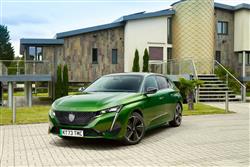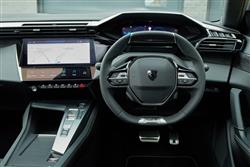Peugeot E-308 - ABC Leasing
How will you view?
This is a sample, showing 30 seconds of each section.
LION BAR(some text hidden)
By Jonathan Crouch
Ten Second Review word count: 46
Conventional family hatchbacks that are also full-EVs are thin on the ground, but Peugeot's E-308 hopes to set a trend for them. It comes in hatch and estate forms and aims to establish some fresh standards for the kind of car a family EV should be.
Background word count: 157
Something we haven't seen much in the current explosion of full-electric compact cars are EV versions of conventional family hatchbacks. True, if you're looking at either a Volkswagen ID.3 or a Kia Niro EV, that's essentially what you've got, but both those manufacturers pretend those cars are Crossovers. Here is something much more straightforward, the Peugeot E-308. In terms of conventional EV family hatches, you could argue that it's the first one we've seen since the Volkswagen e-Golf was discontinued in 2019. Unlike that car, there's more than one body style, an SW estate offered as well as a 5-door hatch. And developed alongside this model with exactly the same 54kWh battery and powertrain are full-electric versions of its close Stellantis Group cousin, the Vauxhall Astra. This 308 was the first of the two cars to market and joins the existing 308 Hybrid Plug-in model for those wanting to make a more eco-minded choice in this segment.
Driving Experience word count: 296
Peugeot's latest 54kWh battery is being rolled out across its EVs at present and of course features here. It incorporates a more sophisticated chemical composition which makes possible a Volkswagen ID.3-rivalling 257 mile range figure. This battery powers a front axle-mounted 156bhp motor which will get you to 62mph from rest in about 10 seconds. That's provided you engage most focused of the three available drive modes - 'Sport'; the others are 'Normal' and 'Eco'. Thanks to Peugeot's usual (but unusual) 'i-Cockpit' driving position, which sees a dinky little steering wheel that's ideal for wrist-flick manoeuvres. As usual in an EV, its central lower down positioning minimises the downside by lowering the centre of gravity. There are no steering wheel paddles to alter brake regeneration. But Peugeot does provide a selectable 'Brake' option on the transmission interface which ups energy harvesting to the point where a lot of retardation can be handled by the brake regen system, rather than by the foot pedal. Ride quality is better than it is on most other compact EVs of this size (and far softer than in the equivalent rather over-firm Vauxhall Astra Electric); you certainly won't be clumping over speed humps and crashing through pot holes in the way we have with some recent small EVs we've tested. And Peugeot's kept wind noise and tyre roar at reasonable levels, so you can get the refinement benefit of that near-silent powertrain. On the top 'GT' model, there's a bit of (rather basic) drive assist technology too, courtesy of an 'Adaptive Cruise Control with Stop & Go' (which automatically maintains your speed to vehicles in front on the highway and when you come across a tailback, will seamlessly bring you to a stop, then when appropriate, automatically start you off again).
Pictures (High res disabled)

.jpg)
.jpg)
.jpg)
.jpg)
.jpg)
.jpg)
.jpg)
.jpg)

Scoring
Category: Compact Car
| Performance | |
| Handling | |
| Comfort | |
| Space | |
| Styling | |
| Build | |
| Value | |
| Equipment | |
| Economy | 70% |
| Depreciation | 50% |
| Insurance | 60% |
| Total | 65% |